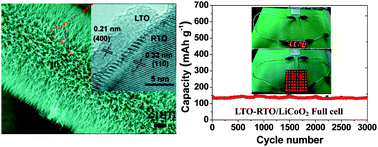Topotactic conversion-derived Li4Ti5O12–rutile TiO2 hybrid nanowire array for high-performance lithium ion full cells†
Abstract
A carbon-free and binder-free Li4Ti5O12–rutile TiO2 (LTO–RTO) hybrid nanowire array electrode has been designed via the partial topotactic conversion of a RTO nanowire array. In such a nanowire electrode: (i) the inner 1D RTO nanowire acts as the electron pathway (conductivity is higher than that of LTO) ultimately providing the electrode with an enhanced conductivity, and RTO also has a higher theoretical capacity (336 mA h g−1) than LTO, thus can essentially improve the capacity of the LTO-based electrode; (ii) the outer LTO is found to have a preferred orientation of (400) planes for facile lithium insertion and its “zero strain” feature is helpful to restrain the slight volumetric expansion of the inner RTO. Accordingly, with the elegant synergistic contribution from LTO and RTO, the optimized 3 : 1 LTO–RTO electrode exhibits high capacity (among the highest: ∼181 mA h g−1 at ∼1 C rate), excellent cyclability and good rate capability. A lithium ion full cell assembled using a LTO–RTO hybrid array as the anode and commercial LCO film as the cathode further shows outstanding performance with an ultralong lifetime (thousands cycles even at ∼10 C) and is capable of powering practical electronic devices, such as Nixie tubes and even an 8 × 8 LED lattice board.


 Please wait while we load your content...
Please wait while we load your content...